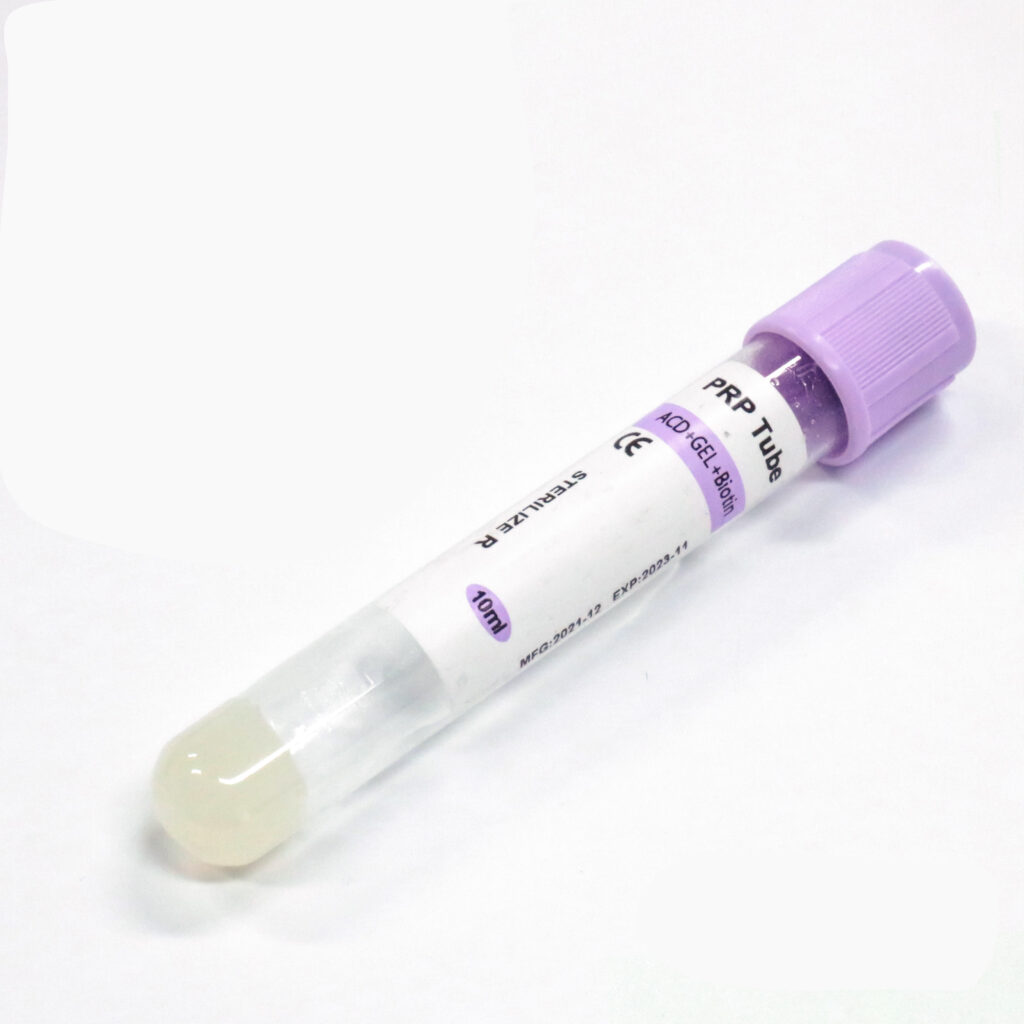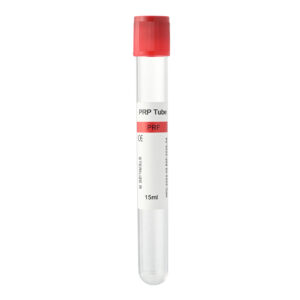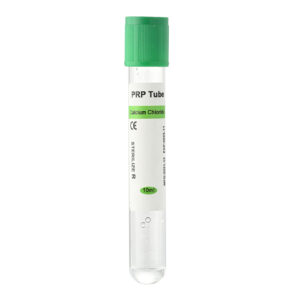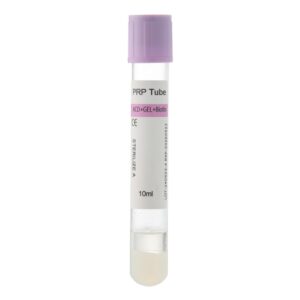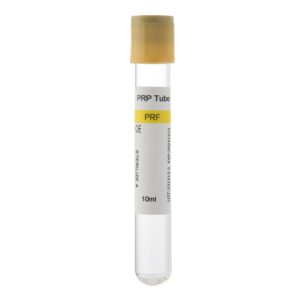ACD+Gel+Biotin PRP, Platelet-rich plasma (PRP) technology has become an innovative treatment in modern medicine, widely applied in tissue repair, regenerative medicine, and aesthetic treatments. ACD+Gel+Biotin PRP is a specific type of PRP that combines an anticoagulant (ACD), a gel separation agent (Gel), and biotin. This combination enhances the efficiency of plasma separation and boosts treatment results. It improves both the extraction and biological activity of PRP, making it highly effective for a range of medical applications.
Components and Mechanism of ACD+Gel+Biotin PRP
ACD+Gel+Biotin PRP consists of three key components: the ACD anticoagulant, Gel separation agent, and Biotin. Each plays a unique role in ensuring precise PRP preparation and maximizing therapeutic effects.
- ACD (Citrate) — The Key Anticoagulant: ACD (Citrate) is a widely used anticoagulant that prevents blood from clotting during collection. It maintains blood flow and prevents clotting while preserving the integrity of the blood components. ACD ensures that platelets, white blood cells, and other blood components remain intact, allowing for precise separation during the PRP process. By controlling the concentration of ACD, the process effectively prevents coagulation and maintains the biological characteristics of the blood, ensuring high-quality PRP.
- Gel (Separation Agent) — Efficient Separation for Higher Purity: The Gel separation agent plays a critical role in the PRP preparation process. During centrifugation, the gel forms a distinct barrier that separates the blood into layers, enabling efficient separation of platelets, red blood cells, and white blood cells. The use of Gel in ACD+Gel+Biotin PRP ensures higher platelet concentration and better overall purity. This leads to more effective PRP for therapeutic use, minimizing the presence of unnecessary cells in the final preparation.
- Biotin — Enhancing Cell Regeneration and Repair: Biotin, a B vitamin, is crucial for promoting cell metabolism, growth, and repair. In ACD+Gel+Biotin PRP, biotin boosts the biological activity of the platelets, enhancing their regenerative properties. Biotin is especially beneficial for skin, hair, and soft tissue repair. It accelerates collagen production and supports tissue healing, making it an ideal addition for improving the overall effectiveness of PRP treatments.
Clinical Applications of ACD+Gel+Biotin PRP
ACD+Gel+Biotin PRP has shown a broad range of clinical applications, with particularly significant benefits in the following areas:
Tissue Repair and Regenerative Medicine
ACD+Gel+Biotin PRP is highly effective in promoting the healing and regeneration of damaged tissues. Healthcare providers widely use PRP in the treatment of joint injuries, tendonitis, and soft tissue damage. By increasing platelet concentration and incorporating biotin, the PRP can stimulate the release of growth factors that accelerate tissue repair and reduce inflammation, speeding up recovery time.
Aesthetic and Skin Care Treatments
PRP has gained popularity in the aesthetic field as a “natural” method for skin rejuvenation. ACD+Gel+Biotin PRP helps reduce wrinkles, improve skin elasticity, shrink pores, and enhance skin tone. The addition of biotin further promotes skin cell vitality and aids in collagen production, resulting in smoother, firmer, and more youthful-looking skin.
Hair Loss Treatment
PRP therapy is becoming a leading treatment for hair loss. ACD+Gel+Biotin PRP works to regenerate and activate hair follicles, promoting hair growth. The biotin in this PRP formulation stimulates the follicles, improving hair density and thickness over time. It has been shown to be effective in treating androgenic alopecia (pattern baldness) and other forms of hair thinning.
Advantages of ACD+Gel+Biotin PRP
- High Separation Efficiency and Pure PRP: The gel separation agent ensures efficient separation of blood components, resulting in a highly concentrated platelet-rich plasma. This leads to more effective treatments with a higher purity of PRP.
- Enhanced Therapeutic Effects and Tissue Repair Support: The inclusion of biotin enhances the regenerative potential of the platelets, accelerating tissue repair and recovery. Biotin also contributes to faster healing of damaged areas, improving overall treatment outcomes.
- High Safety and No Additional Load on the Body: All components used in ACD+Gel+Biotin PRP are well-researched and widely used in clinical applications. They have been proven safe for use without causing extra strain or side effects during treatment.
- Simple Process, Widely Applicable: The PRP preparation process with ACD+Gel+Biotin is straightforward and easy to execute, making it accessible to a wide range of medical institutions and aesthetic clinics. This simplicity helps reduce treatment costs and makes the therapy more widely available.
Conclusion
ACD+Gel+Biotin PRP represents an advanced, safe, and effective solution for various medical and aesthetic treatments. Combining the benefits of ACD anticoagulant, Gel separation agent, and Biotin, it offers higher-quality platelet-rich plasma that accelerates tissue regeneration and repair. Whether used for tissue healing, skin rejuvenation, or hair restoration, ACD+Gel+Biotin PRP demonstrates remarkable potential in enhancing healing processes.
PRP Common Questions and Answers (Q&A)
1. What is PRP?
Answer: PRP (Platelet-Rich Plasma) is a blood product derived from the patient’s own blood, enriched with platelets, growth factors, and other regenerative components. It is obtained through a centrifugation process and is commonly used for tissue repair and regeneration in fields like medicine, dentistry, orthopaedics, and more.
2. What are the applications of PRP?
Answer: PRP is mainly used in the following areas:
- Orthopedics: To treat soft tissue injuries and arthritis and promote healing in joint-related issues.
- Dentistry: To accelerate dental implant healing, gum regeneration, and bone healing.
- Dermatology: For skin rejuvenation, wound healing, and hair restoration (PRP injections for hair loss).
- Aesthetic Medicine: PRP facials are used to stimulate skin repair and improve skin texture.
3. What are the results of PRP treatment?
Answer: PRP treatment promotes tissue healing and regeneration by stimulating the body’s natural healing mechanisms. Results vary based on the individual patient, but multiple treatment sessions are typically needed to achieve the best results. Often, appropriate rehabilitation is recommended alongside treatment.
4. Is PRP treatment safe?
Answer: Since PRP is derived from the patient’s own blood, the risk of allergic reactions or rejection is very low. Side effects are typically minimal, but some patients may experience slight swelling, bruising, or tenderness at the treatment site.
5. How long does PRP treatment take?
Answer: Healthcare providers typically perform PRP treatment in an outpatient setting, with the procedure lasting between 30 minutes to 1 hour, depending on the treatment area and scope. Most patients can resume daily activities shortly after the procedure, although they should avoid vigorous exercise and local stimulation for a short period.
6. How do I choose the right PRP tubes and centrifuge?
Answer: When choosing PRP tubes, ensure that the material, design, and gel formula meet the treatment requirements. The gel inside the PRP tube helps separate the blood components and optimizes platelet concentration. Healthcare providers should adjust the centrifuge speed and duration according to the tube and treatment needs to ensure effective platelet separation.
7. Is PRP treatment suitable for everyone?
Answer: PRP treatment is generally suitable for most patients seeking tissue repair or healing. However, individuals with blood disorders, immune system issues, or those who are pregnant may not be candidates. Healthcare providers recommend a thorough evaluation by a medical professional prior to treatment.
8. How many sessions of PRP treatment are required?
Answer: The number of sessions needed depends on the individual’s condition and treatment goals. Typically, healthcare providers require 1 to 3 sessions, with intervals of 4 to 6 weeks between treatments. The number of sessions can be adjusted based on the patient’s response and desired results.
9. How does PRP differ from other treatments?
Answer: Unlike traditional drug treatments or surgeries, PRP therapy uses the patient’s own biological components, avoiding the side effects associated with foreign substances. It enhances the body’s natural healing process and is considered a relatively safe and low-risk alternative with minimal side effects.
10. What should I consider when using PRP tubes?
Answer: When using PRP tubes, it’s important to follow strict protocols for blood collection and centrifugation. Ensure the tubes are intact before use, and carefully calibrate the centrifuge settings. Healthcare providers must maintain a clean and sterile environment to prevent contamination and ensure optimal treatment outcomes.

